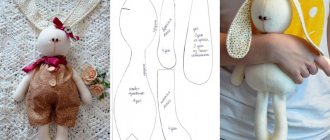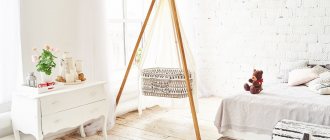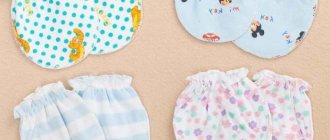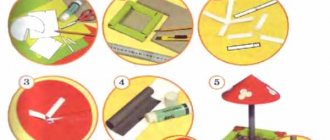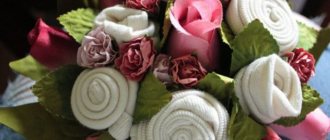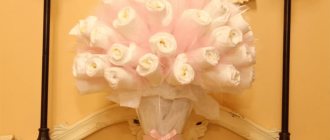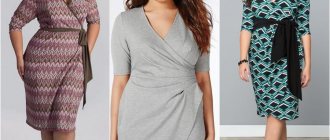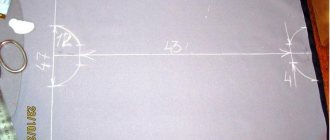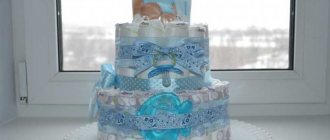The birth of a child is always a joy, so you want to give the baby all the best and not forget about safety. And if all the items of “children’s everyday life” will come in handy a little later, then clothes will be needed from the first moments of life. To ensure your baby’s safety, you need to do everything yourself. Therefore, we follow the following rule - we sew for newborns with our own hands, patterns for which you can “design” interesting things yourself. To do this, you need to accurately determine the quality fabric and model of this or that version of the product.
Selection of materials and accessories
Newborns are fragile and delicate creatures, so clothes for them should be as comfortable as possible. In the first year of life, it is preferable to use soft and always natural fabrics for sewing.
Babies should choose thin cotton fabrics. It’s also a good idea to get some things made of flannel and terry. For mobile and active children over one year old, it is more practical to sew clothes from knitwear. Of the connecting materials in newborn clothes, it is preferable to use soft Velcro. Let the small buttons wait until they are a year old.
Original and beautiful do-it-yourself envelopes for discharge, photo
The set includes an envelope and an original hat for a newborn.
Summer discharge envelope.
Envelope - a blanket with a drawstring for a girl.
Winter discharge envelope.
Summer envelope for newborn discharge.
Envelope with ruffles.
Fur envelope.
Envelope with a cap.
Determining children's sizes
Before starting work, you should determine what exactly the mother is going to sew for the child. When preparing clothes for future use, it is important to take into account that newborns grow very quickly, so there is simply no point in preparing a dozen caps and vests of the same size. Modern motherhood has also been simplified by diapers, which have relieved parents of the need to sew cloth diapers. For one newborn baby, 6-7 diapers, 3-4 vests and 2-3 caps of the same size will be enough.
To understand what size clothes your baby needs, you can use standard approaches to determining it. The following data is used for sewing:
- From birth to 1 month, the child's height is 50−56 cm. Chest girth is 36 cm, head girth is 33−35 cm. These measurements correspond to size 18.
- From 1 to 3 months, height is in the range of 56−62 cm, chest circumference is 40 cm, and head circumference is 35−40 cm. For these measurements, size 20 is suitable.
- 3-6 months: height 62-68 cm, chest circumference - 44 cm, head circumference - 40-42 cm. For these data, size 22 is suitable.
- From 6 to 9 months, the child grows to 68−74 cm, his chest circumference reaches 48 cm, and his head reaches 40−42 cm. Size 24.
- 12−18 months - the child reaches 74−80 cm, and his chest circumference is 52 cm. Head circumference is 44−46 cm. Size 26.
When sewing children's clothing, you should remember that measurements at each age fluctuate with a difference of several centimeters. These features depend on the weight and gender of the child . This fact should be taken into account if things are being prepared for future use.
Pros of homemade clothing
Before deciding to make their own clothes, many mothers weigh the pros and cons. Creating clothes for babies is not only interesting and simple, but also useful. The advantages of such products are the following factors:
- By choosing the simplest patterns, even a beginner will be able to cope with the work, creating unique items in a single copy. It turns out that the thing is completely designer.
- Only high-quality materials will be used for production.
- You can choose any color scheme and create a unique finish.
- The sizes may be non-standard, since the pattern is made independently.
- In addition to clothes, you can make other items for the baby, which can also additionally decorate the house.
- Thanks to original combinations and experiments, you can create truly universal things.
- This skill can become the basis of a business for a mother on maternity leave, since every item will be non-standard.
Sewing items for newborns yourself is not difficult if you do everything correctly and carefully.
Positives about sewing things yourself
Every year fashion brings new versions of models not only for an adult wardrobe, but also for children. You can bring a lot of things to life yourself - sew things yourself, and not only things. For everything to work out, you need to correctly remove the marks from the newborn and prepare a pattern. The work itself will not take much time, but it will definitely bring a lot of pleasure. Moreover, when designing things, you can show your imagination and choose the materials you like.
Diapers and thin sheets
The simplest product for a newborn is a diaper. No special skills are required in sewing this part. Typically, diapers are made in two versions - warm and thin sheets. The fabric should be soft, natural and with a soft pattern.
An ordinary diaper is a rectangle measuring 90 by 120 cm. The dimensions can also be 110 by 80 cm. To sew a dozen diapers, you will need 12 meters of fabric. For thin items, it is better to purchase chintz. To sew warm sheets, use flannel or flannelette fabric.
To sew diapers, a piece of fabric is marked with a pencil into 10 parts. Next, the material is cut and the edges are processed. Use a zigzag or overlock for this. It is better not to use hems at the edges of diapers for newborns. When the diapers are ready, it is recommended to wash them again and iron them on both sides.
What fabrics are best to use?
After you have already decided what to sew for the newborn with your own hands, you also need to select suitable textiles for this. The material must meet certain standards:
Variety of children's things
- Safety in terms of composition and hygiene.
- Strength that guarantees wear resistance.
- Comfort guaranteed by the pleasant surface texture.
- A high degree of hygroscopicity is required.
- Air permeability so that the baby's skin breathes and does not rot.
- It is better to avoid items that wrinkle during wear.
- The material should not fade during the washing process, since this procedure is carried out frequently.
Variety of fabrics for sewing
Additional information! When choosing a material, you need to additionally consider what season it will be used for.
There are many natural and synthetic textile options on the market. Many mothers have doubts about what type to choose for sewing clothes for a newborn. Experienced seamstress-mothers have come up with an exact rule - the closer the clothes are to the baby’s body, the more natural their composition should be. There are several fabric options that are ideal for newborns:
- A very popular option is chintz - a fabric with a standard weave of fibers. Mainly used for sewing diapers and light summer clothes.
- Flannel, which is divided into subtypes: cotton, wool, wool blend, is considered relevant. Can be used for sewing demi-season undershirts, pajamas, overalls, rompers and dressing gowns.
- Terry is a lightweight and versatile material option. Pleasant to the touch, easy to care for, absorbs moisture well and warms. Suitable for diapers, towels, scratch covers, caps.
- Knitted fabrics, which in turn are divided into footer, kulirka, interlock, ribana, capiton. Relevant for making almost any item for a newborn.
- Fleece can be used for sewing “outerwear”. Blouses and overalls that will be worn over more natural clothing.
- Calico will be a rolled-up alternative to chintz, but it is mainly used to make bedroom accessories - crib bumpers, sheets, mattress covers.
Calico for children's underwear
There are other types of fabrics, which in their composition are only ¼ or ½ natural fibers. Some options can also be used to make clothes for newborns. The most popular are velsoft and polyester.
You may be interested in: Patterns and procedures for sewing clothes for a doll on your own
Hats and caps
One of the mandatory parts of a baby's wardrobe is a cap. It's easy to sew. It is enough to choose a soft natural fabric and cut out the details correctly. You can use ready-made clothing patterns for children, as well as create your own with an original design. An elegant hat will be useful for discharge from the maternity hospital or for baptism.
To create a cap pattern, it is enough to take just one measurement. This is the half-circumference of the head. To remove it, you need to measure the circumference of the baby's head, placing the tape in the places where the back of the head and forehead protrude most.
For a head circumference of 48 cm, the half-circumference will be 24 cm. To construct the back of the head of the pattern, use the following calculations:
- AB = ½ OG: 4 + 1.5 = 24: 4 + 1.5 = 7.5 cm;
- AD = ½ OG: 2 + 3 = 24: 2 + 3 = 15 cm.
To construct a rectangle, you need to calculate using other formulas. To do this you will need to make the following calculations:
- AB = ½ OG: 2 = 24: 2 = 12 cm;
- AD = sewing line length = 20 cm.
As you can see from the pattern picture, seam allowances are already included in the pattern. The edges on the front part should be processed. The best option would be a tape that will hide all the seams.
If the fabric is not soft enough, it is advisable to sew the parts with the seam facing out. For a girl, you can decorate the cap with lace.
Envelope-cocoon
If you are preparing an envelope in advance for welcoming a newborn from the maternity hospital and want to make this event even more solemn and memorable, sew it yourself. To do this you will need cotton fabric, insulation, Velcro fasteners and a zipper. The scheme is simple. We make a pattern based on the classic approximate baby data. The shape will resemble a bag. We transfer the pattern to the fabric, cut it out, connect the parts, attach Velcro in a place convenient for you so that you can easily open and close the cocoon. The resulting baby clothes can be decorated with ribbons, beads or appliqués on any theme.
Scratch mittens for babies
The safety and comfort of a child is especially important in the first months of life, when the baby has not yet learned to control his movements and can harm himself. To protect the baby, scratch mittens will be useful.
It is not difficult to sew such a product. For one pair of mittens you need to cut out four base parts and two elastic bands. The elastic measures 6 x 10 centimeters plus half a centimeter seam allowance.
As a base you will need a semicircle of fabric, the length of which is 15 cm and the width is 10 cm. Seam allowances have already been taken into account here. Step-by-step instruction:
- The main parts, folded right side out, are swept away.
- The elastic is sewn on the side, then turned inside out and folded in half.
- The elastic is basted to the scratch and the seam is treated with an overlocker.
The scratches are ready. Using interesting ideas and designs, you can make cute mittens that can later be kept in your mother's box as a keepsake.
Patterns for children are not only blanks for sewing clothes. The newborn will also need a cozy envelope in which he can walk during the first months of life.
Headband
As a rule, newborn children do not yet have hair, but parents really want to decorate the child’s head. In this case, children's headbands come to the rescue, which you can sew with your own hands in less than an hour.
Measure the circumference of the child's head and set aside the same amount on the material of your choice. Don't forget to leave two centimeters for the seam. Cut a strip of fabric and connect both ends. Decorate the product to your liking. The children's headband is ready.
Useful tips, simple toy patterns
The photo shows interesting hand-sewn soft toys:
If you are sewing soft toys with your own hands for the first time, then you should prepare in advance both financially and mentally, otherwise the process may be delayed. The material base consists of preparing the necessary materials and tools necessary for the work:
- suitable material, pieces of multi-colored fabrics, pieces of ribbons, lace, leather, etc.;
- threads of different colors;
- filler – padding polyester, cotton wool, holofiber, etc.;
- special fittings in the form of eyes and nose, or suitable buttons;
- auxiliary tools - needles, sharp scissors, pliers, awl, etc.;
- materials for patterns - paper, soap or chalk, meter, etc.; to create a pattern, it is better to use thick cardboard rather than thin paper;
- iron;
- sewing machine or hands.
Mentally, you should prepare for the fact that your first homemade soft toy may not turn out to be as luxurious and beautiful as in the picture or in the master class. But if you involve children in your handicraft experiments and entrust them with part of the work, then the final result will not be so important. At the same time, we do not forget about safety precautions: we give out sharp objects only at the appropriate age and under the supervision of adults.
The photo shows different toy patterns for beginners:
You can start creating small things - buy a ready-made master class in a store, which includes all the necessary materials and detailed instructions. After making the first soft animal or doll, you can move on to a “free” flight of imagination and independent work.
When it comes to materials, we primarily pay attention to natural or hypoallergenic fabrics and safe fillers, since most of the toys end up in the hands of children and do not gather dust on shelves and chests of drawers.
Useful video on how to make a pattern:
Mustachioed-striped
There is probably no child who would not be delighted by the playful faces of cute kittens. But not every mother is ready for a heroic act - to have a live pet in her apartment.
Sew funny toys from fabric, stuff them with cotton wool, synthetic padding or stuffing from old pillows. Add accessories at your discretion, for example, a scarf for a cat or an openwork bow for a cat.
Photo: smelovdelo.ru
Photo: livemaster.ru



